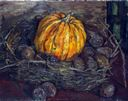Aleksandr Ivanovich Ovchinnikov does not have an image.
Aleksandr Ivanovich Ovchinnikov
(1929 - )
Alexander Ovchinnikov was born in 1929 in the village of Bahlaka Novosergievsky in the Orenburg region. Though one of eleven children, Ovchinnikov quickly distinguished himself, as an artist, in an already well-respected family. Ovchinnikov is most famous as a painter of the expansive Russian steppe and countryside. It is said that his deft handling of this subject matter was a natural response to his family's closeness to the land. Ovchinnikov has always worked from the soul, even after surviving the harsh thirties and the Kulak liquidation. He endured famine and hunger, living on anything he could find without losing his faith in justice and the beauty of life. He counted himself lucky to be among a people who, in spite of their trials, continued to take pride in the verdant joy of their homes, creating beautiful wooden ornaments, embroidered towels, homespun rugs, lace curtains, tablecloths, and valances, some of which feature in his still-lives. His elder brother Pantsyalei, killed in action during world War II, was also a talented draughtsman, but Ovchinnikov was left to take up the brush, and, through experimentation, learn how to paint. To that end, it is said that Ovchinnikov was more an artist than he ever was a fighter. After primary school, during the Patriotic War, Ovchinnikov was sent to learn how to drive a tractor for a collective farm. At the time, the country severely lacked strong young men who could do such work. Though an artist at heart, work on the collective probably saved Ovchinnikov from the same fate as his older brother. After the war, in 1946, Ovchinnikov went to Nesterivka, where he became a Kudashev artist. Kudashev, a great artist of the time, took notice of Ovchinnikov's talent and invited him to study in Orenburg. There, he stayed with Kudashev, while also making the acquaintance of the artists Stepanova and Petina. Fortunate to have this network of inspiring artists, Ovchinnikov became a painter and designer of theater backdrops, while continuing his education at night school. In 1947 he had his first exhibition in the regional Museum of Fine Arts, where seven of his works were shown. The audience warmly greeted his works, and he had two purchases. Patrons admired his precision and extraordinary sense of color. This first show was followed by a meticulous and thoughtful effort to improve his navigation of the complex roads and secrets of the art world, especially in Soviet Russia. About thirty of his works are represented in the Orenburg Museum of Fine Arts. Ovchinnikov's works display a broad and open poignancy hinting at his optimistic outlook on life. Furthermore, his paintings are noted for their fresh look in spite of the over eighty years which have passed since the beginning of his career.
(1929 - )
Alexander Ovchinnikov was born in 1929 in the village of Bahlaka Novosergievsky in the Orenburg region. Though one of eleven children, Ovchinnikov quickly distinguished himself, as an artist, in an already well-respected family. Ovchinnikov is most famous as a painter of the expansive Russian steppe and countryside. It is said that his deft handling of this subject matter was a natural response to his family's closeness to the land. Ovchinnikov has always worked from the soul, even after surviving the harsh thirties and the Kulak liquidation. He endured famine and hunger, living on anything he could find without losing his faith in justice and the beauty of life. He counted himself lucky to be among a people who, in spite of their trials, continued to take pride in the verdant joy of their homes, creating beautiful wooden ornaments, embroidered towels, homespun rugs, lace curtains, tablecloths, and valances, some of which feature in his still-lives. His elder brother Pantsyalei, killed in action during world War II, was also a talented draughtsman, but Ovchinnikov was left to take up the brush, and, through experimentation, learn how to paint. To that end, it is said that Ovchinnikov was more an artist than he ever was a fighter. After primary school, during the Patriotic War, Ovchinnikov was sent to learn how to drive a tractor for a collective farm. At the time, the country severely lacked strong young men who could do such work. Though an artist at heart, work on the collective probably saved Ovchinnikov from the same fate as his older brother. After the war, in 1946, Ovchinnikov went to Nesterivka, where he became a Kudashev artist. Kudashev, a great artist of the time, took notice of Ovchinnikov's talent and invited him to study in Orenburg. There, he stayed with Kudashev, while also making the acquaintance of the artists Stepanova and Petina. Fortunate to have this network of inspiring artists, Ovchinnikov became a painter and designer of theater backdrops, while continuing his education at night school. In 1947 he had his first exhibition in the regional Museum of Fine Arts, where seven of his works were shown. The audience warmly greeted his works, and he had two purchases. Patrons admired his precision and extraordinary sense of color. This first show was followed by a meticulous and thoughtful effort to improve his navigation of the complex roads and secrets of the art world, especially in Soviet Russia. About thirty of his works are represented in the Orenburg Museum of Fine Arts. Ovchinnikov's works display a broad and open poignancy hinting at his optimistic outlook on life. Furthermore, his paintings are noted for their fresh look in spite of the over eighty years which have passed since the beginning of his career.
Artist Objects
